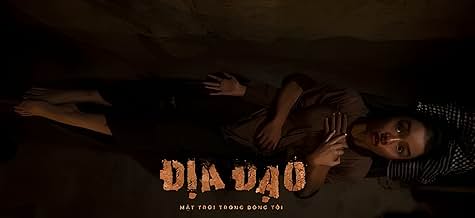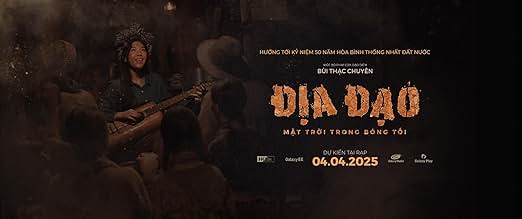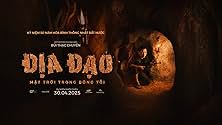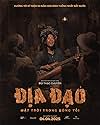Füge eine Handlung in deiner Sprache hinzuIn 1967, as the Vietnam War raged, a Vietnamese revolutionary guerrilla team became the U.S. military's top target - charged with safeguarding a secret group of intelligence agents at all co... Alles lesenIn 1967, as the Vietnam War raged, a Vietnamese revolutionary guerrilla team became the U.S. military's top target - charged with safeguarding a secret group of intelligence agents at all costs.In 1967, as the Vietnam War raged, a Vietnamese revolutionary guerrilla team became the U.S. military's top target - charged with safeguarding a secret group of intelligence agents at all costs.
Empfohlene Bewertungen
Tunnel: Sun in the Dark is a Vietnamese historical war drama that plunges audiences into the heart of the Vietnam War's most turbulent years. Directed by Bui Thac Chuyen, this film is both a personal and national tribute-a vivid re-creation of the life and sacrifice of the guerrilla fighters who once hid in the labyrinthine tunnels of Cu Chi during 1967.
A Glimpse Into History Set against the backdrop of the Vietnam War's deadliest phase, the film follows a small but resolute guerrilla unit of 21 fighters. Under the steady command of Bay Theo (portrayed by Thai Hoa), the group is tasked with protecting a covert strategic intelligence team from the relentless assault of American forces. The narrative, drawn from real historical events, captures the stark realities of combat and the unsung heroism of soldiers fighting not for glory but for survival and the future of their nation.
Storytelling and Direction Bui Thac Chuyen's directorial approach is both innovative and rooted in authenticity. Instead of opting for a linear, conventional war story, he employs interwoven narratives that mirror the chaotic and fragmented nature of wartime existence. This technique not only maintains a constant sense of tension and mystery but also forces viewers to actively engage with the unfolding events-much like the soldiers themselves, who had to piece together survival strategies under dire circumstances.
The film deliberately eschews overt, bombastic heroism. Instead, it emphasizes the day-to-day struggles, the bittersweet moments of camaraderie, and the subtle, raw expressions of human vulnerability. In doing so, the director transforms the tunnel itself into a character-a silent witness to the myriad sacrifices and quiet acts of defiance that defined this chapter in Vietnam's history.
Production Design and Cinematography One of the film's standout achievements is its meticulous production design. To accurately recreate the claustrophobic and dangerous environment of the Cu Chi tunnels, the production team built a 250-meter-long tunnel model, capturing the oppressive darkness and narrow passageways that the real-life guerrilla fighters navigated daily. The cinematography further amplifies this sense of entrapment and urgency. With skillful use of light and shadow, the camera work draws viewers into the subterranean world where every footstep carries the weight of uncertainty and impending danger.
Stellar Performances The film's cast delivers remarkably authentic performances that elevate the entire production. Thai Hoa, reprising his role as Bay Theo, imbues the character with a palpable sense of duty and internal conflict. His portrayal is both commanding and deeply human, reflecting the heavy burdens of leadership amidst chaos.
Quang Tuan's dedication to his role as Tu Dap is evident-his physical transformation, achieved through rigorous weight loss and intense physical training, underscores the extremes to which the actors went to mirror the hardships of the era. Meanwhile, Ho Thu Anh and Diem Hang Lamoon bring emotional depth and nuance to their respective characters, capturing the delicate balance between fierce determination and personal vulnerability. Their performances add layers to the narrative, making the film's portrayal of war not just about physical battles, but about the internal battles of hope, love, and loss.
Themes and Emotional Impact At its core, Tunnel: Sun in the Dark is more than a war film-it's a meditation on sacrifice, resilience, and the price of freedom. The film's stark realism forces audiences to confront the brutality of war: the constant fear, the physical and emotional toll, and the profound sense of isolation experienced by those who fight from the shadows. Yet, amidst this darkness, the film also reveals moments of tender humanity-brief flashes of laughter, quiet gestures of solidarity, and even the fragile stirrings of romance. These interludes serve as poignant reminders that even in the bleakest of times, the human spirit continues to seek connection and meaning.
Conclusion Tunnel: Sun in the Dark stands out as a significant achievement in Vietnamese cinema. With its painstaking attention to historical detail, innovative narrative structure, and deeply affecting performances, the film offers a window into a past marked by sacrifice and unwavering resolve. It challenges the audience to reflect on the true cost of freedom and the enduring legacy of those who fought-not for fame or fortune, but for the very soul of their nation.
For anyone interested in a film that is as intellectually engaging as it is emotionally stirring, Tunnel: Sun in the Dark is a must-watch. It is a cinematic journey that not only redefines the war genre but also reaffirms the indomitable spirit of Vietnam's people.
A Glimpse Into History Set against the backdrop of the Vietnam War's deadliest phase, the film follows a small but resolute guerrilla unit of 21 fighters. Under the steady command of Bay Theo (portrayed by Thai Hoa), the group is tasked with protecting a covert strategic intelligence team from the relentless assault of American forces. The narrative, drawn from real historical events, captures the stark realities of combat and the unsung heroism of soldiers fighting not for glory but for survival and the future of their nation.
Storytelling and Direction Bui Thac Chuyen's directorial approach is both innovative and rooted in authenticity. Instead of opting for a linear, conventional war story, he employs interwoven narratives that mirror the chaotic and fragmented nature of wartime existence. This technique not only maintains a constant sense of tension and mystery but also forces viewers to actively engage with the unfolding events-much like the soldiers themselves, who had to piece together survival strategies under dire circumstances.
The film deliberately eschews overt, bombastic heroism. Instead, it emphasizes the day-to-day struggles, the bittersweet moments of camaraderie, and the subtle, raw expressions of human vulnerability. In doing so, the director transforms the tunnel itself into a character-a silent witness to the myriad sacrifices and quiet acts of defiance that defined this chapter in Vietnam's history.
Production Design and Cinematography One of the film's standout achievements is its meticulous production design. To accurately recreate the claustrophobic and dangerous environment of the Cu Chi tunnels, the production team built a 250-meter-long tunnel model, capturing the oppressive darkness and narrow passageways that the real-life guerrilla fighters navigated daily. The cinematography further amplifies this sense of entrapment and urgency. With skillful use of light and shadow, the camera work draws viewers into the subterranean world where every footstep carries the weight of uncertainty and impending danger.
Stellar Performances The film's cast delivers remarkably authentic performances that elevate the entire production. Thai Hoa, reprising his role as Bay Theo, imbues the character with a palpable sense of duty and internal conflict. His portrayal is both commanding and deeply human, reflecting the heavy burdens of leadership amidst chaos.
Quang Tuan's dedication to his role as Tu Dap is evident-his physical transformation, achieved through rigorous weight loss and intense physical training, underscores the extremes to which the actors went to mirror the hardships of the era. Meanwhile, Ho Thu Anh and Diem Hang Lamoon bring emotional depth and nuance to their respective characters, capturing the delicate balance between fierce determination and personal vulnerability. Their performances add layers to the narrative, making the film's portrayal of war not just about physical battles, but about the internal battles of hope, love, and loss.
Themes and Emotional Impact At its core, Tunnel: Sun in the Dark is more than a war film-it's a meditation on sacrifice, resilience, and the price of freedom. The film's stark realism forces audiences to confront the brutality of war: the constant fear, the physical and emotional toll, and the profound sense of isolation experienced by those who fight from the shadows. Yet, amidst this darkness, the film also reveals moments of tender humanity-brief flashes of laughter, quiet gestures of solidarity, and even the fragile stirrings of romance. These interludes serve as poignant reminders that even in the bleakest of times, the human spirit continues to seek connection and meaning.
Conclusion Tunnel: Sun in the Dark stands out as a significant achievement in Vietnamese cinema. With its painstaking attention to historical detail, innovative narrative structure, and deeply affecting performances, the film offers a window into a past marked by sacrifice and unwavering resolve. It challenges the audience to reflect on the true cost of freedom and the enduring legacy of those who fought-not for fame or fortune, but for the very soul of their nation.
For anyone interested in a film that is as intellectually engaging as it is emotionally stirring, Tunnel: Sun in the Dark is a must-watch. It is a cinematic journey that not only redefines the war genre but also reaffirms the indomitable spirit of Vietnam's people.
The movie follows a scrappy 21-person Vietnamese guerrilla squad that ends up in the crosshairs of a US forces search and destroy mission. Their task is to protect a newly arrived strategic intelligence team hiding at their base, no matter what it takes. The plot isn't overly complex, so the film hooks you more with the characters' inner struggles than with battlefield tactics.
I really liked how the story kicks off with a lost soldier stumbling into the guerrilla team's tunnel network. It sparks some funny and engaging moments that flesh out the bonds between the Vietnamese soldiers. But as the film hits its midpoint, the escalating tension of the war with the US army starts to drown out those emotional connections. I get why it shifts that way, but it's a pity the soldiers' sacrifices didn't land with more weight. It would've hit harder if the director had ramped up the emotional stakes, especially when the guerrilla leader, a key figure, meets his end. That moment deserved a bigger payoff.
There's a touch of sex in the film too nothing overdone, and it feels grounded. I think it's a realistic nod to something rarely explored in stories about Vietnam War soldiers. After all, these are young guys in their prime, still human despite the chaos.
The sound design really stands out. The director nails the raw punch of bombs and gunfire. Visually, it's strong too smart camera angles and solid framing. That's a huge plus in making the film feel real as it brings history to life.
I really liked how the story kicks off with a lost soldier stumbling into the guerrilla team's tunnel network. It sparks some funny and engaging moments that flesh out the bonds between the Vietnamese soldiers. But as the film hits its midpoint, the escalating tension of the war with the US army starts to drown out those emotional connections. I get why it shifts that way, but it's a pity the soldiers' sacrifices didn't land with more weight. It would've hit harder if the director had ramped up the emotional stakes, especially when the guerrilla leader, a key figure, meets his end. That moment deserved a bigger payoff.
There's a touch of sex in the film too nothing overdone, and it feels grounded. I think it's a realistic nod to something rarely explored in stories about Vietnam War soldiers. After all, these are young guys in their prime, still human despite the chaos.
The sound design really stands out. The director nails the raw punch of bombs and gunfire. Visually, it's strong too smart camera angles and solid framing. That's a huge plus in making the film feel real as it brings history to life.
Tunnel 2025 is an emotional and realistic portrayal of the struggles and sacrifices made during a pivotal time in Vietnam's history. The film does a great job capturing the raw emotions and the human side of war, making it more than just a historical retelling-it's a story that touches the heart.
While some scenes were a bit difficult to follow, especially for viewers unfamiliar with certain historical contexts, the overall message remains powerful. The film serves as a reminder of the determination and unity that helped shape our nation.
Vietnamese youngsters should definitely watch Tunnel 2025. It's not just a film-it's an opportunity to better understand the sacrifices our ancestors made and the lengths they went to in order to reunite our country.
While some scenes were a bit difficult to follow, especially for viewers unfamiliar with certain historical contexts, the overall message remains powerful. The film serves as a reminder of the determination and unity that helped shape our nation.
Vietnamese youngsters should definitely watch Tunnel 2025. It's not just a film-it's an opportunity to better understand the sacrifices our ancestors made and the lengths they went to in order to reunite our country.
Vietnamese cinema has long explored the theme of war, but few films have approached it with the scale, precision, and emotional resonance of The Tunnels: Sun in the Shadows. Directed by Bui Thac Chuyen, this film not only reconstructs a brutal chapter of Vietnamese history but also boldly asserts that Vietnam is capable of producing war films with both artistic integrity and cinematic ambition.
When the setting becomes the protagonist
Inspired by the Cu Chi tunnel system during the Vietnam War, the film takes place in 1967-one of the war's most intense years. However, the true protagonist here is not a person, but the tunnels themselves: a claustrophobic, living ecosystem beneath the ground. Through tight, shadow-filled cinematography and minimal lighting, the audience does not simply observe life underground-they inhabit it, feeling the heat, the tension, and the ever-present fear.
There are no long expositions or forced monologues. Instead, the film tells its story through images and silence: sweaty faces, rushed meals, and hushed conversations drowned out by planes overhead. The director trusts the audience to understand fear and resilience through breath, glances, and stillness.
Deliberate pacing with emotional weight
The first half of the film unfolds slowly, immersing viewers in the daily rhythms of tunnel life. Some may find the pacing subdued, but it is a deliberate choice-to portray the quiet persistence and fragile humanity of soldiers living beneath the soil. When the enemy's incursion begins, the tempo shifts, yet the film avoids turning into an action spectacle. Even the combat scenes are crafted with clarity and restraint, maintaining emotional resonance over spectacle.
Complex characters with moral ambiguity
Beyond the tunnels, three central characters anchor the narrative: Commander Bay Theo (played by Thai Hoa), engineer Tu Dap (Quang Tuan), and fighter Ba Huong (Thu Anh). Each represents a different facet of wartime survival: Bay Theo is gruff yet introspective, Tu Dap is intelligent but emotionally volatile, and Ba Huong is both courageous and vulnerable.
Crucially, the film does not idealize its characters. They make mistakes, carry flaws, and experience moments of fear. But it is precisely their imperfections that make their courage meaningful. Their humanity emerges not from their heroism but from their internal conflict.
Minor flaws, major impact
Despite its strengths, the film has a few shortcomings. The tunnel structure may be disorienting for some viewers unfamiliar with the setting. Some secondary characters feel underdeveloped, and the second act occasionally loses focus due to uneven pacing and editing. Nevertheless, the emotional payoff of the final act is strong enough to outweigh these limitations.
Conclusion
The Tunnels: Sun in the Shadows is a bold and thoughtful entry in the landscape of Vietnamese war cinema. It avoids patriotic excess and sentimentality, choosing instead to portray war through an intimate, human lens. With restrained dialogue, immersive visuals, and emotional subtlety, the film demonstrates that Vietnam does not need to imitate Hollywood to create powerful cinema.
If Vietnamese cinema is to reach the global stage on its own terms, The Tunnels is strong evidence that it already has the tools, stories, and vision to do so.
When the setting becomes the protagonist
Inspired by the Cu Chi tunnel system during the Vietnam War, the film takes place in 1967-one of the war's most intense years. However, the true protagonist here is not a person, but the tunnels themselves: a claustrophobic, living ecosystem beneath the ground. Through tight, shadow-filled cinematography and minimal lighting, the audience does not simply observe life underground-they inhabit it, feeling the heat, the tension, and the ever-present fear.
There are no long expositions or forced monologues. Instead, the film tells its story through images and silence: sweaty faces, rushed meals, and hushed conversations drowned out by planes overhead. The director trusts the audience to understand fear and resilience through breath, glances, and stillness.
Deliberate pacing with emotional weight
The first half of the film unfolds slowly, immersing viewers in the daily rhythms of tunnel life. Some may find the pacing subdued, but it is a deliberate choice-to portray the quiet persistence and fragile humanity of soldiers living beneath the soil. When the enemy's incursion begins, the tempo shifts, yet the film avoids turning into an action spectacle. Even the combat scenes are crafted with clarity and restraint, maintaining emotional resonance over spectacle.
Complex characters with moral ambiguity
Beyond the tunnels, three central characters anchor the narrative: Commander Bay Theo (played by Thai Hoa), engineer Tu Dap (Quang Tuan), and fighter Ba Huong (Thu Anh). Each represents a different facet of wartime survival: Bay Theo is gruff yet introspective, Tu Dap is intelligent but emotionally volatile, and Ba Huong is both courageous and vulnerable.
Crucially, the film does not idealize its characters. They make mistakes, carry flaws, and experience moments of fear. But it is precisely their imperfections that make their courage meaningful. Their humanity emerges not from their heroism but from their internal conflict.
Minor flaws, major impact
Despite its strengths, the film has a few shortcomings. The tunnel structure may be disorienting for some viewers unfamiliar with the setting. Some secondary characters feel underdeveloped, and the second act occasionally loses focus due to uneven pacing and editing. Nevertheless, the emotional payoff of the final act is strong enough to outweigh these limitations.
Conclusion
The Tunnels: Sun in the Shadows is a bold and thoughtful entry in the landscape of Vietnamese war cinema. It avoids patriotic excess and sentimentality, choosing instead to portray war through an intimate, human lens. With restrained dialogue, immersive visuals, and emotional subtlety, the film demonstrates that Vietnam does not need to imitate Hollywood to create powerful cinema.
If Vietnamese cinema is to reach the global stage on its own terms, The Tunnels is strong evidence that it already has the tools, stories, and vision to do so.
10Eie-95
As an American viewer, I walked into Tunnels: Sun in the Dark expecting a compelling war film. I walked out transformed. This is not just a war movie. It is poetry carved into the darkness of history, a cinematic requiem for those who fought battles unseen, underground, and in the shadows of superpowers. The director delivers a harrowing, intimate, and profoundly human story set during one of the most divisive conflicts in modern history: the Vietnam War. Set in 1967, Tunnels follows a Vietnamese revolutionary guerrilla team entrusted with protecting a hidden group of intelligence agents-the heartbeat of their resistance. What unfolds is not only a tense and thrilling survival narrative but an exploration of loyalty, sacrifice, and the slow-burning light of hope that flickers even in the blackest tunnels. The film's cinematography is nothing short of stunning. The contrast between the oppressive, suffocating underground passages and the rare, golden moments of daylight evokes both fear and longing. You can feel the earth pressing in. You can hear the silence between each heartbeat. And in those moments, you understand what it meant to live like a shadow. The performances-raw, restrained, and utterly magnetic-do not seek applause. They seek truth. Particularly standout is the lead guerrilla commander, whose eyes alone speak volumes of sorrow, determination, and unyielding resolve. The writing never panders. It respects the intelligence of its audience while remaining unflinchingly honest about the toll of war on both body and soul. As an American, I was humbled. Tunnels: Sun in the Dark does not preach, vilify, or romanticize. It illuminates. It reminds us that history is not owned by the victors alone. It belongs to the buried voices, the hidden fighters, the forgotten dreams that once burned bright in the dark. This film is a gift-a mirror held to the past, but also a light for our collective future. Watch it. Feel it. Remember it. 10/10 - A masterpiece that should echo through every corridor of film history.
Wusstest du schon
- Alternative VersionenAn alternate version, titled the Director's Cut, was released on April 30, 2025. This cut is 3 minutes shorter than the original theatrical version.
Top-Auswahl
Melde dich zum Bewerten an und greife auf die Watchlist für personalisierte Empfehlungen zu.
Details
- Erscheinungsdatum
- Herkunftsland
- Offizieller Standort
- Sprache
- Auch bekannt als
- Địa Đạo: Mặt Trời Trong Bóng Tối
- Drehorte
- Produktionsfirmen
- Weitere beteiligte Unternehmen bei IMDbPro anzeigen
Box Office
- Budget
- 2.240.000 $ (geschätzt)
- Weltweiter Bruttoertrag
- 6.641.870 $
- Laufzeit
- 2 Std. 8 Min.(128 min)
- Farbe
- Sound-Mix
- Seitenverhältnis
- 2.76 : 1
Zu dieser Seite beitragen
Bearbeitung vorschlagen oder fehlenden Inhalt hinzufügen






